Particular Jarama
* # 10522
* # 10528
* # 10350
* # 10684
#10350
Since 1977, I have a passion for Lamborghini. At first, buying magazines and later Lambo books I was impressed and dreaming about the only one Jarama featured in most of them : Bob Wallace Special or Rally.
For ever, race attraction is leading many guys to invest money and time in order to compete against each other or to build an awesome racing car. Well, I’ve lived this too as you may have read it in my Introduction. I know pretty well what Wallace was surely thinking by that time : “Building a competitive racing car”.
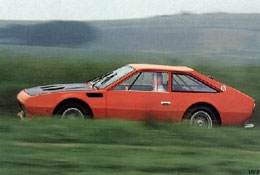 |
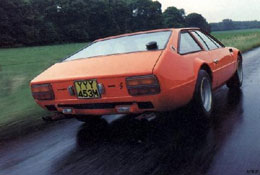 |
Some sources indicated Jarama Special was standing at factory in 1973 & 1974. Then it went to France to end in Saudi Arabia. By late ‘80s, it was discovered by an English guy in really bad shape who had brought it back to UK at Portman’s place in order to restore it. Jarama Special rebirth was featured in 3 issues of Supercar Classic magazine that leads me to believe by that time it will be for sale one day or another. Unfortunately, I never saw the “For Sale” advertising...and I’m still expecting to meet Wallace Special Jarama one day or another.
Here are the 3 articles of Supercar Classic :
December 1990 : "Not yet available"
January 1991 : "Not yet available"
February 1991 : "Not yet available"
Here is another story : Racing Orange Lamborghini Jarama by Roberto Giordanelli
Copyright © 2001 International Lamborghini Registry
Copyright © 2001 Auto Italia
“Ferrucio Lamborghini had a 'no racing’ policy, but this didn't stop his chief engineer Bob Wallace from building competition cars.
If this car were a motorcycle, it would be a cafe-racer. You remember the sort of thing: modified, lightweight, uncomfortable, rebellious, anti-social and most important of all FUN. However, in this case you don't need to get wet when it rains or race to the roundabout and back before the Eddie Cochran record on the juke-box has finished.
The first Jarama were the 400 GT versions made in 1970, they made 250 cars before the 400 GTS arrived in 1972. Jarama production ceased in 1976. Only 150 GTS were built. To put this in perspective, the first of a total of 900 Miura was built in 1966 and the first Countach in 1973. These were two-seaters while the Jarama was a four-seater. The Bertone styled Jarama replaced the Marazzi styled 400 GT Islero while another four-seater, the Espada overlapped them from 1967-78. This is where we need the period's top financial journalist to explain how all this exotica could have been produced in such low numbers. The 1990s financial mind boggles.
'Our' one-off RS Jarama was originally the creation of Bob Wallace, a New Zealander, who was Lamborghini's development mechanic and chief test driver in the 1960s and 1970s. Lamborghini were never officially involved in motor racing although there were many in the Company who wanted it. Wallace never missed an opportunity to help with the development of quicker Lamborghinis. One suspects that Lamborghini allowed the RS's development to happen just to keep Wallace happy. Even if it did not race, it did attract press attention. Wallace wanted to see lighter, faster Lamborghinis. He thought that their comfort should be compromised for out and out performance, but Ferrucio Lamborghini thought otherwise. Wallace was pro-racing. In fact many of Lamborghini's engineers were drawn from other famous competition orientated companies in the Modena Triangle. However, Ferrucio Lamborghini recognised the risk of financial suicide and kept out of motor sport. At least he can console himself and rest peacefully with the fabulous Miura, a serious contender for the 'Best Car Ever Made' prize, even though it could literally take-off at 180+ mph.
In 1972, during a quiet period in a tough economic climate, Bob Wallace took the bull by the horns (get it?). He built the car from a bare shell, re-welding where necessary to stiffen it. A lightweight steel rear roll-cage was also fabricated to aid stiffness. The engine bulkhead was cut away to allow the engine to be mounted further back to improve weight distribution. This necessitated a new dash and transmission tunnel which intruded further into the cockpit. The battery was relocated into what was a rear passenger seat and a cut-off switch fitted. The standard car had a weight distribution of 53/47 front/rear which was not bad for a front engine car. Wallace's Jarama had a near 50/50 weight balance. Centre-lock Miura wheels, 8 and 10 inches wide, were fitted with 215/70 and 225/70 VR Michelin XWXs. Four standard ventilated disc brakes were used with extra ducting to the front. The double wishbone, independent suspension was modified with Koni racing shock absorbers with adjustable spring platforms. This not only makes the ride height easily adjustable, it makes corner-weight adjustment possible. If you don't understand the need for corner weight adjustment, think of a wobbly restaurant chair. With a car of course, you can't wedge a folded up napkin under one of the wheels.
Chunks of the floor pan were cut away and replaced with aluminium. This is not as bad as it sounds, since the floor has more than its fair share of box sections. In fact the aluminium was fitted over the box sections from underneath to smooth the airflow under the car. Aluminium doors and bonnet were also fitted. The bonnet incorporated huge extraction ducts to carry the hot radiator air over the car rather than around the engine and underneath. Further ducts to reduce under-bonnet temperature were made in the scuttle just ahead of the windscreen. The aluminium doors were fitted with sliding Plexiglas windows and contributed greatly to the weight reduction. Apart from the windscreen, all the glass was changed for Plexiglas. A startling snow plough of a front spoiler jutted out brazenly. The headlamps were moved down and the swivelling shifty-eyed covers welded closed saving the weight of their motors, etc. A large aluminium petrol tank was made and fitted above the rear axle. The interior was trimmed in lightweight materials and Miura low-back seats were fitted with 3-point harnesses.
 |
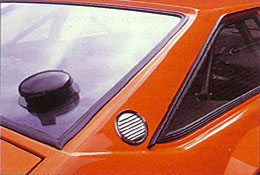 |
In standard form, the four- litre V 12 produced a claimed 365bhp at a wailing 7,800rpm. In those days it was not unknown for dynamometers to be, shall we say, optimistic. Speedometers were also prone to exaggerate. However, if you do your sums and estimate a conservative volumetric efficiency, then four litres pumping at nearly 8,000rpm will produce not far short of 1OObhp/litre, i.e. about 365 bhp. For the Wallace RS Jarama this was not good enough. Larger (42 DCOE) Weber carburettors were used with longer ram-pipes to bring back the torque lost through the larger venturis. No air filters were fitted, just wire gauze to keep out the really big rocks. Flywheel, pistons and conrods were lightweight and balanced. A larger oil cooler was fitted while the gearbox and differential remained standard.
A standard Jarama GTS weighed about 1,470 kgs.(dry weight). The one-off 'RS' has lost around 300kgs. weighing in at an estimated 1,170kgs (dry weight), about the same as a modern 1.8-litre saloon car.
The Jarama RS was used by Wallace to frighten the motoring journalists of the period. He had little time for most of them or their opinions since he believed they were unable to drive fast cars anywhere near their limit.
For many years the Wallace Jarama RS lay forgotten and derelict. It was discovered about five years ago (1990) in the Saudi Arabian desert and was shipped to Portman, the UK Lamborghini Concessionaires, who had the job of restoring the car. This was overseen by the very capable, hands-on and no-nonsense engineer Del Hopkins. The car has undergone a full ground-up restoration. Originality has been respected up to a point. Superior 1990s two-pack paint has been used. The cooling fans have been changed for Countach items and the interior retrimmed in modern materials.
For this test, the car was collected from the showroom of Talacrest in Surrey where, apart from being in distinguished company, it is for sale (WAS for sale at the time of this article!). Whether or not it is to your taste, it is quite striking in its bright orange and matt black. While from the rear it looks quite tame (for a Lamborghini), from the front it looks like a mouse-trap. Its prominent looks attract much attention, although without spotting the badge, few know what it is.
The lightweight doors open and close faster and easier than you are ready for, an instant reminder of what this car is about. The interior has that home-made racer feel. The tunnel is trimmed in that fab '60s "cocktail bar" quilted PVC which is so hard to find these days. Black Alcantara suede covers just about everything else. A huge 300km/h speedo and 10,000 rpm tacho dominate the special RS dash. The minor instruments are mounted well back in the binnacle and unless you have eyes in your neck you won't see them.
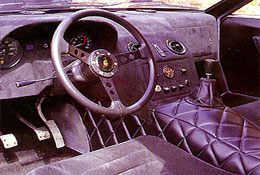 |
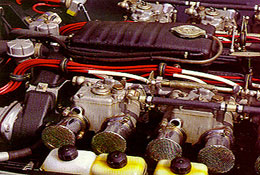 |
My experience with Jarama goes back to the 1970s when I first drove a GTS in anger and then again in the mid '80s when I drove another. The starting procedure is the same with all carburettor Lambos. Ignition on, wait for the note-change of pumps to finish filling the carbs. Pump the throttle pedal its full travel four or five times allowing the twelve pump jets to squirt fuel through the twelve butterflies, engage the starter and 'catch' the engine with a light throttle when it fires.
When the water temperature needle has moved off its stop you are ready to move off gently through the inevitable crowd of "what'll it do mister?" onlookers. With the Jarama RS, the non-powered steering, which is difficult to turn at parking speeds, comes into its own at speed, the worm and roller box damping out the high frequency shocks without loss of feel to the driver. Geometry calibrations are critical on Lamborghinis. They are transformed into terrific driving machines when correctly set-up. So many are set-up wrongly and in many cases the owners are oblivious to what they are missing.
The RS rides firmer than a normal Jarama as you might expect. The spring-rate frequency is less than in a racing car but firm enough to enable you to throw the car into bumpy road turns safely. Turn-in response is average, not loading up too much maybe because of reduced castor angle. Fast cornering brings neutral handling, with oversteer if you go mad. Because it is a high geared GT car, power induced oversteer will require quick reactions to cope with the massive wheel-spin available. Body-roll is less than with a standard car although the anti-roll bar diameters are unchanged; an effect of lightening the car.
Braking and down-changing are excellent. The pedal effort and travel is just right, leaving your right foot perfectly positioned to twist and blip the jerk-free throttle pedal. The gearbox synchros work perfectly, encouraging you to change gear just to hear the exhilarating sound of an unrestricted high revving V12. Going too slow or in the wrong gear brings on detonation. Either the ignition is too advanced or the fuel is not good enough, all the more reason to keep the revs up.
A non-original red line has been stuck on the outside of the tacho glass at 5,500rpm, no doubt as an insurance against an expensive blow-up. As previously mentioned, a standard Jarama GTS produces 365bhp at 7,800 rpm. The mods to this car should show around 380bhp at 8,000 rpm. From experience, I can tell you that to be an anti-social menace and have fun, you need to keep the needle between 5,000-7,500rpm. At these revs, with its open induction tracts, the Jarama RS wails and whoops from both ends.
While Jaguar and Mercedes make smoother, torquier and more reliable V12s, these old Lamborghini engines make the best music. With these cafe-racers, you take the juke-box with you.
Additional Note: This car sold on June 20, 1996 for $47,795 and has since been in the hands of a German owner though still registered on British plate and occasionally run on German dealer plates.”
|
TECHNICAL SPECIFICATIONS |
ENGINE |
Front Mounted 60° V12 all alloy, |
FUEL SYSTEM |
Bendix Pumps |
IGNITION |
2 Marelli distributors (single Marelli distributor). |
POWER |
*380bhp at 8,000rpm (365bhp at 7,500rpm). |
GEARBOX |
Lamborghini 5-speed. |
DIFFERENTIAL |
Lamborghini LSD. |
WHEELS |
Chromodora |
TYRES |
Michelin XWX |
BODY |
Bertone, 2 seats. (2+2 seats) |
PERFORMANCE |
0-60 mph: *6 sec. (6.8 sec.) |
Text and photos courtesy of http://www.auto-italia.co.uk/